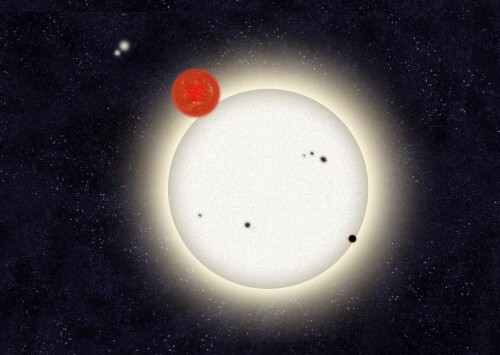The enthusiasts, who examined data from the Kepler space telescope, discovered that the planet actually orbits a pair of stars (or a double star), which in turn orbits a second pair of stars. This is the first system of its kind ever discovered

Recently, a planet was discovered orbiting one of the suns in a system with no less than four suns. Something reminiscent of Isaac Asimov's immortal story "Sunset". The story describes a planet illuminated by the pine of six suns, so that its inhabitants do not know what darkness is. The story is about the occurrence of a solar eclipse that hides all the suns and causes a complete blackout on the surface of the planet. The short story describes the events that take place in the hours leading up to the eclipse and the book expands on what happened on the star before the eclipse and in the days after.
The planet actually orbits a pair of stars (or a double star), which in turn orbits a second pair of stars.
This is the first system of its kind that has ever been discovered and the discovery illustrates the power of amateur astronomers because the discovery was made in collaboration between amateur astronomers who are members of the "Planet Hunters" website Planet Hunters Under the guidance of professional astronomers.
This planetary configuration is probably very rare, says Meg Schwamb, an astronomer at Yale University. Only six planets have ever been discovered orbiting a double star, and none of these suns orbit other partners. Astronomers call this planet "circumbinary" (that is, it surrounds two suns).
Circumbinary systems are the most extreme place for planet formation, says Schwamb, a scientist who helps the Planet Hunters website and is the lead scientist in a paper about the systems presented Oct. 15 at the annual meeting of the Division of Planetary Sciences at the American Astronomical Society in Reno, Nevada.
"Discovering these systems requires us to go back to the drawing board and understand how such planets can assemble from primordial material and evolve in these challenging dynamic environments." saying.
The planet is called PH1, meaning it is the first confirmed planet of Planet Hunters citizen), but it was also nicknamed Tatooine, the planet from the Star Wars movies that orbits two suns.
Planet hunters analyze the data transmitted by the Kepler spacecraft, and have been trained to search for planets.
The volunteers, Kian Jack of San Francisco and Robert Galliano of Arizona saw small dips in light caused by the planet's passage in front of its parent star, a well-known method for detecting planets outside the solar system. Schwemb, a postdoctoral fellow at Yale, led the team of professional astronomers who confirmed the discovery and characterized the planet, using observations from the Keck Observatory in Mauna Loa, Hawaii. PH1 is a gas giant with a radius 6.2 times that of Earth, which makes it slightly larger than Neptune-Rabh.
"Planet Hunters is a symbolic project, increasing the ability to discover these objects through citizens and tracking these objects by teams of astronomers" says Debra Fisher, professor of astronomy at Yale and an expert on planets who helped start the project in 2010. "This unique system would have been missed if not for the sharp eyes of the people from the general public."
PH1 orbits the pair of stars that are 1.5 and 0.41 solar masses in 20-day orbits. The planet is compressed. Its mass is estimated to be 170 times that of Earth, and its diameter is about half that of Jupiter. It orbits the pair of stars about once every 138 days. Beyond the planet's orbit, at a distance of a thousand astronomical units (an astronomical unit is the distance between the earth and the sun - 150 million kilometers) there is a second pair of stars that surround the planetary system.

6 תגובות
Maybe this system shows a temporary situation that won't last long?
Maybe many star systems start out with multiple suns, then break up?
Maybe our system also started with a twin star, and over time disintegrated?
How old is the system that was discovered, and how can we tell if existing systems once had a twin star?
Apparently a system that actually contains 4 stars or even 3 is rare to non-existent. The amount of interference will break the system down very quickly
Tomer,
What a great story! Ahhhh Asimov.
You and the article kept me going back to my middle school days 🙂
I don't think it will be possible to see the pair of suns that are 1000 astronomical units away from the planet the way we see our sun...
Probably the two distant suns will see the planet in the sky as we see Venus in the morning.
Sunset.. 🙂